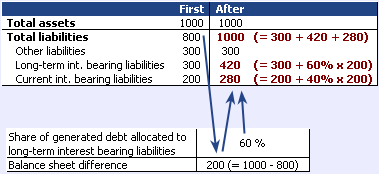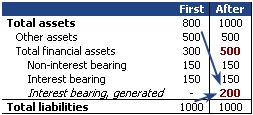How the Balance sheet is made even?
When you estimate Balance sheet for current and future years, it is very usual that the bottom lines do not equal. You do not, however need to correct the imbalance yourself; the model makes it for you.
Let us see how the correction is made in both situations, i.e when assets are bigger or when liabilities are bigger.
1. Assets are estimated to be bigger

There are three parameters that you have to input:
1. Minimum level of interest bearing long-term liabilities
2. Minimum level of interest bearing current liabilities
3. Share of debt allocated to long-term (interest bearing) liabilities
You may also leave the first two parameters to be zero. In this case the company do not necessary have any interest bearing debt at all. If you leave the third parameter to zero, all the generated debt are allocated to interest bearing current liabilities.
At first, the model calculates the difference of assets and liabilities. In this phase your minimum level requirements have already been taken into account. Then the model simply allocates the balance sheet differences to long-term and current liabilities according to what you have determined the share to be.
Here is an example what happens when assets are estimated to be bigger. You do not actually see this happening, it is just the logic behind the model.

2. Liabilities are estimated to be bigger

When liabilities are bigger than assets, the process is simpler. The balance sheet difference is totally allocated to Generated interest bearing financial assets. They are an item in Total financial assets.
Here is an example what happens when assets are estimated to be bigger. You do not actually see this happening, it is just the logic behind the model.

3. What happens when the situation changes?
Let’s say that first the assets are estimated to be bigger and the model has allocated the balance sheet differences to long-term and current liabilities like in example one. Then the profitability decreases rapidly and the estimates will be adjusted downwards. What happens in this situation:
The model will first reverse the adjustment it has made before, so basically opposite of the example number one will happen. While the cash generated will decrease, also the generated debt will decrease. If the model still cannot find balance with these operations, it will continue to add Generated interest bearing financial assets. The model will continue this until the balance sheet is again even.
In the opposite situation the liabilities are first estimated to be bigger, but then assets grow bigger for some reason. Again the model will first reverse the adjustments made before: It will decrease the debt to the minimum level (set by the analyst) and only after will start generating cash.



